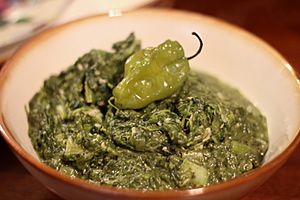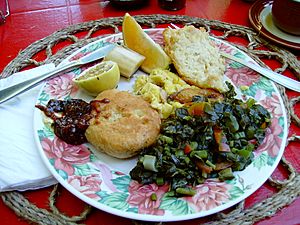Callaloo facts for kids
 |
|
| Type | Stew |
|---|---|
| Place of origin | Caribbean |
| Created by | African descendants |
| Main ingredients | Leaf vegetable (usually taro, amaranth or Xanthosoma) |
Callaloo is a super popular vegetable dish from the Caribbean! You might see it spelled in different ways, like kallaloo or calaloo. It's a bit like a stew and is made with different leafy green vegetables. The exact ingredients can change depending on which Caribbean island you are on.
The main ingredient is usually a local leafy plant. This could be amaranth (sometimes called callaloo itself), taro leaves (also known as dasheen bush), or Xanthosoma leaves (which might be called cocoyam or tannia). Because some of these plants are also called "callaloo," it can sometimes get a little confusing! This delicious dish has roots in West African cooking traditions.
Contents
How Callaloo is Cooked in Different Places
Callaloo is made in many unique ways across the Caribbean. For example, in Trinidad and Tobago, Grenada, and Dominica, people mainly use taro leaves, also called dasheen bush. Dominicans sometimes use water spinach too.
In Jamaica, Belize, and Saint Lucia, the word callaloo usually means the amaranth plant. Jamaicans use amaranth in many dishes, and even make a drink called "callaloo juice." The way callaloo is made in Jamaica is quite different from how it's made in Trinidad and Tobago or Grenada.
Jamaican Callaloo
Jamaicans often steam their callaloo leaves. They add tasty ingredients like tomatoes, salt, peppers, onions, and scallions. Sometimes, they also include saltfish. It's a common and yummy breakfast food!
Trinidadian and Saint Lucian Callaloo
In Trinidad and Tobago and Saint Lucia, callaloo is made with dasheen bush (taro leaves) and okra. They also add coconut milk, pumpkin, onions, bell peppers, and local spices. Sometimes, they even put in crabs or pigtails! This version of callaloo is often served as a side dish. It can be like a thick, green gravy for other foods. Callaloo is one of the national dishes of Trinidad and Tobago and Dominica.
Plants Used for Callaloo Leaves
Many different leafy plants can be used to make callaloo. Here are some of the most common ones:
- Taro: This plant is also called dasheen in the West Indies. Its leaves are a key ingredient in the Trinidadian version of callaloo.
- Tannia or malanga: This plant is also known as calalu or "yautía" in Puerto Rico.
- Amaranth: There are several types of amaranth used. Amaranthus spinosus is popular in the West Indies. Amaranthus viridis is used in Jamaica.
- Pokeweed species: One type is Phytolacca octandra, sometimes called "West Indian foxglove."
- Nightshade species: Solanum americanum is another plant used.
- Water spinach: This plant is a type of morning glory.

Delicious Callaloo Recipes
Callaloo is a very important dish throughout the Caribbean. It uses plants native to the region and has been influenced by African cooking traditions, like adding okra. Trinidadians have made this dish their own, adding ingredients like coconut milk to make it even more flavorful.
Callaloo as a Side Dish
Callaloo is usually served as a side dish. In Trinidad, Barbados, and Grenada, it often comes with rice, macaroni pie, and a choice of meat. In Guyana, it's made in different ways, often without okra.
Grenadian Callaloo
In Grenada, callaloo is steamed with garlic, onion, and coconut milk. It's often blended until it's smooth and creamy. Grenadians also enjoy a hearty callaloo soup, especially on Saturdays. This soup can have callaloo, okra, dumplings, and different meats like chicken and beef. Callaloo is also a main ingredient in oil down, which is Grenada's national dish. Oil down is a stew made with breadfruit, callaloo, dumplings, and various meats, all steamed in coconut milk.
Callaloo in the Virgin Islands
In the Virgin Islands, callaloo is typically served with a side dish called fungee.
Callaloo in Guadeloupe
In Guadeloupe, a special dish called calalou au crabe (crab callaloo) is a traditional meal for Easter.
A similar dish called laing is popular in the Philippines, especially in the Bicol region.
See also
 In Spanish: Calalú para niños
In Spanish: Calalú para niños


